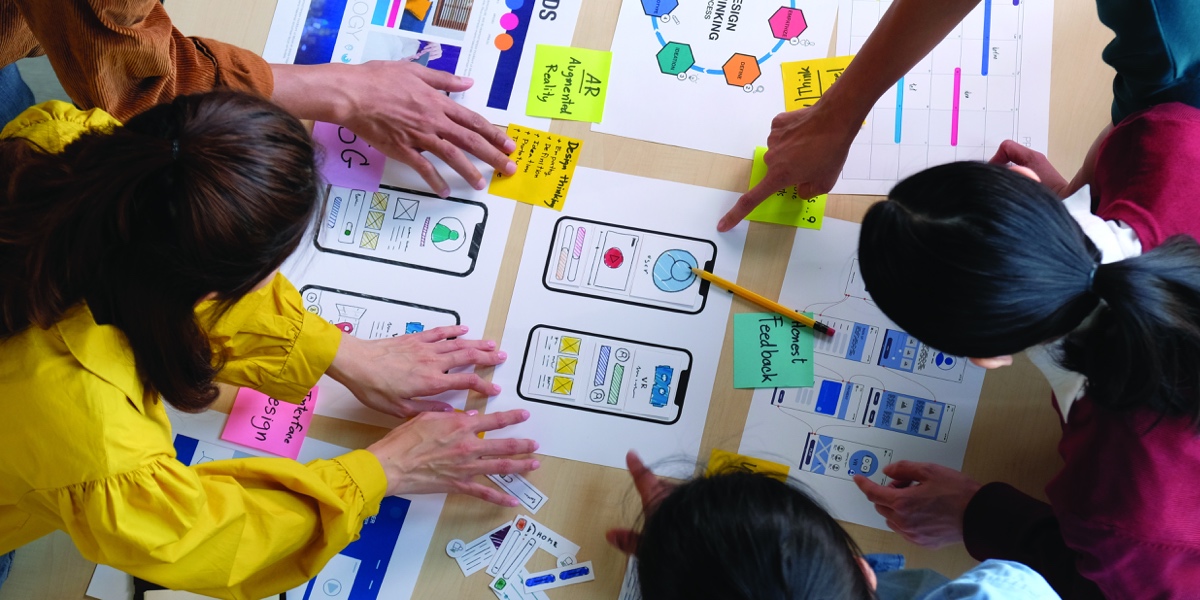Design thinking is at the very heart of the UX design process. And key to the design thinking process is a little activity many of us have been familiar with since grade school: brainstorming.
Brainstorming is the act of coming up with as many ideas as possible in order to find a solution to a given problem. Simple enough, right? Although it seems simple, brainstorming can be quite difficult for many designers. Here’s why.
Brainstorming is an integral part of design thinking and requires some attention—especially during the ideation phase of the design thinking process.
During this phase, designers work with the rest of the team to spark off as many creative solutions as possible. However, many designers’ minds can easily either draw a blank, or come up with so many ideas they feel overwhelmed and lost in the possibilities.
Coming up with innovative and focused solutions quickly takes practice—that’s why we’ve created a list of some of the best design thinking exercises to kickstart your brainstorming. We’ll cover five of the most essential exercises, as well as how to adapt them for remote collaboration.
The techniques we’ll discuss are as follows:
- SCAMPER
- SWOT analysis
- Six Thinking Hats
- Group sketching and brainwriting
- Mind mapping
- Final thoughts
These techniques will be sure to enhance your ideation skills and give you plenty of material to work with as you move from ideation to prototyping.
For an introduction to the design thinking process, check out this video presented by me, design expert and mentor Camren Browne. Otherwise, jump straight to the techniques!
Ready to learn about these helpful brainstorming methods? Let’s get started.
1. S.C.A.M.P.E.R
This easy-to-remember mnemonic was created in 1953 by Alex Osborn, co-founder of the international advertising agency BBDO. The SCAMPER technique works great for creating new products, but is more often used for improving already existing products.
SCAMPER is a mnemonic—each letter stands for a process or concept that allows participants to question and test different ideas by looking at them from a different angle. The pneumonic goes like this:
S—Substitute: What element within the product can be swapped with something else and what would happen?
C—Combine: What can be combined and how would this affect the product?
A—Adapt: What aspects of the product can be adapted to a different context and how?
M—Modify: What can be modified to improve the product?
P—Put to other uses: Are there any other uses this product can serve?
E—Eliminate: Is there anything within the product that can be removed to make it simpler?
R—Rearrange or reverse: What can be reversed or rearranged to make this product better?
An easy way to complete the SCAMPER method is to divide your workspace into seven sections and write your answers to each prompt within the section.
To stay focused while performing the SCAMPER technique, you can set the same time limit for each topic and write down as many ideas as you have within that timeframe.
If you’re working in a large group, have participants write their ideas on sticky notes and place them within each section at the end of the allotted time.
Adaption for remote collaboration
This one is simple. Create a Mural and set up the different sections of your workspace.
This will give you a strong visual component, and you can “summon” members to different areas of the mural, explain the process, set a timer, and go. Participants can set up text boxes or digital post-its to note down their ideas.
You’ll probably want to use this in combination with your favorite video conferencing tool.

2. SWOT analysis
A SWOT analysis (Strengths, Weaknesses, Opportunities, Threats) is a pretty common technique for entrepreneurs and business founders when analyzing competing organizations and forming their own business model. UX designers may be familiar with SWOT analysis when completing a competitive analysis. This tool is also great for analyzing and organizing the ways in which your own project can be improved.
To perform a SWOT analysis on your product, all you’ll need is a piece of paper or other writing surface and a pen or marker. Simply divide your workspace into four sections—one for each letter of the acronym—and give yourself or your team a designated amount of time to answer the following questions about your product:
- Strengths: What about this product works well? What do you like the most about it?
- Weaknesses: What about this product isn’t working well? What do you dislike the most about it?
- Opportunities: What opportunities do you see for it to improve? What should it have more of?
- Threats: Are there similar products you should be aware of? Who are your competitors and what makes them stand out?
Answering these questions can give you and your team a good base of information about your product and how to improve it. The S.W.O.T. analysis is a great exercise to carry out when getting a feel for how you perceive your product, how it compares to similar or competing ventures, and different opportunities for growth.
Adaption for remote collaboration
You can easily accomplish this exercise by utilizing online meeting tools like Zoom or WhereBy in combination with online whiteboard/brainstorming tools like Mural—or even a shared Google Doc or Jamboard, depending on how interactive you want the session to be for your team.
3. Six Thinking Hats
Similar to the SCAMPER method, Six Thinking Hats forces you to look at a problem from many different areas of thought. Invented by psychologist Edward de Bono in 1985, this exercise forces designers to place themselves into another’s shoes by wearing a different “hat.” These “hats” are as follows:
- White Hat:Logic—what are the facts and what info do we have?
- Yellow Hat: Optimism—what’s good right now?
- Black Hat:Devil’s Advocate—what are the risks?
- Red Hat: Emotion—what does your gut tell you?
- Green Hat: Creativity—are there other uses or alternatives?
- Blue Hat: Management—are the rules of the exercise being followed?
This brainstorming activity works best with a design team of at least six people but can easily be used by solitary designers as well.
If you’re working with a group, have each participant wear one hat (figuratively, or literally too!) for each session. Each contributor will take on the perspective of the hat they are wearing for the entirety of the brainstorming session.
For instance, if you’re wearing the black hat you’ll be thinking of what could go wrong or why the project might fail. If you’re wearing the green hat, you’ll be trying to find creative ways you can use or improve the product. If working alone, set a designated time to wear each hat until you’ve looked at your project from all six points of view. Be sure to take good notes!
Adaption for remote collaboration
Doing this remotely might mean that you can’t ask folks to wear actual hats to coordinate with the one you assign them—but it can still be done in creative ways.
You can take a similar approach here as you would with SCAMPER or SWOT by utilizing a Mural or a Jamboard in combination with a chat or video conferencing tool. If you want to simplify, you can just use a tool like Miro, which includes brainstorming tools, video chat capabilities, and tool integrations!
4. Group sketching and brainwriting
These brainstorming techniques recruit the combined creative power of multiple designers to produce an exponential amount of innovative ideas. As the name suggests, group sketching and brainwriting are great methods to use when working with many members of a design team but they can be adapted for remote designers as well.
Group sketching
To perform a group sketching section, you and the members of your design team will agree upon the subject you are trying to create or expand upon. This could be an onboarding screen, a logo, or maybe a webpage.
Each participant will start with their own piece of paper and a writing tool. Set a timer for 2-3 minutes and let each member sketch their own idea for the product. Once the time is up, every participant passes their paper to another member who then adds their own ideas to the page. This continues until each participant has had a chance to add to every original sketch.
Working alone? Try performing a Crazy 8’s exercise where you create 8 different versions of your design (ie. a wireframe, mockup, logo etc.) and then stepping away from your work for a few minutes. After a short break, revisit your designs with a fresh mind and try adding to or revising each creation as you would in the group sketching exercise above.
Brainwriting
Brainwriting is a brainstorming technique that is very similar to group sketching. But instead of sketching out a screen or product design, participants are simply writing their ideas down on a sheet of paper. Once the time is up, they pass their ideation notes on to the following team members who then add their own ideas to what the original participant wrote.
Brainwriting is a great way to recruit a lot of different perspectives at once. This method helps design teams think of multiple ways to solve a problem and then expand upon them.
Adaption for remote collaboration
For this kind of exercise, you can ask participants to use materials they already have, wherever they are, and to share them via whatever video conferencing tool your team likes to use. With this, you’ll encounter obstacles when participants need to add on to a teammates’ sketch.
Go fully digital by using Mural or Miro for more real time collaboration. You could also use a combination of your favorite video conferencing tool and whatever remote design collaboration tool your team uses (we recommend InVision or Figma—depending on your team’s budget and preferences).

5. Mind mapping
UX designers are often trying to solve and minimize any hangups or friction their users encounter when interacting with a particular product. Mind mapping helps designers organize their ideas on how to solve these problems and gives a good visual representation of what steps they’ll need to take our resources they’ll need to acquire.
To create a mind map, follow these steps:
- Start by writing down your task or problem to be solved in the center of your design space. Pencil and paper or a whiteboard should work well for this exercise.
- Next, start writing out ideas around your problem that touch on what you need for the issue to be solved. For instance, if your problem is “low conversion rates,” you might write “more engaging visual design,” “a call to action,” or “easier app navigation” around it to create a primary layer of solutions.
- Then try to come up with ways to accomplish these smaller, individual problems by writing out possible solutions in a secondary layer. For example, for “more engaging visuals” you might write “revise fonts,” “change color scheme,” or “add animations.”
Continue adding to your mind map until you feel you’ve exhausted all your options and have a thorough breakdown of the problem at hand. You can then use your mind map to help determine which solutions would be the most impactful, feasible, and cost-effective for your project.
Adaption for remote collaboration
Mind mapping is an exercise you can easily conduct remotely with tools like MindMeister, Figma, or Balsamiq. You may want to use these tools in combination with a chat or video conferencing tool. You can simplify a bit with a tool like (again!) Miro—even if it’s not intended purely for mind mapping.
6. Final thoughts
Whether you’re starting your own creative project or working among a team of designers, there’s a pretty good chance you’ll need to put on your brainstorming cap at least a few times until the product is complete.
Use the above techniques to help make your brainstorming sessions as productive and helpful as possible. Try not to be too strict on yourself and look upon your ideas and the ideas of others with a non-judgemental attitude.
Encourage wacky or non-traditional ideas, focusing more on quantity at this point rather than quality. Gather your resources (pen, paper, sticky notes, whiteboard etc.), give yourself a time limit, and let the ideas flow!
If you and your team hit a creative wall, here are a couple of resources to help:
- How to overcome creative block as a UX designer
- 5 Game-changing examples of design thinking in practice (get inspired!)
If you’d like to learn more about design thinking, check out these articles:

